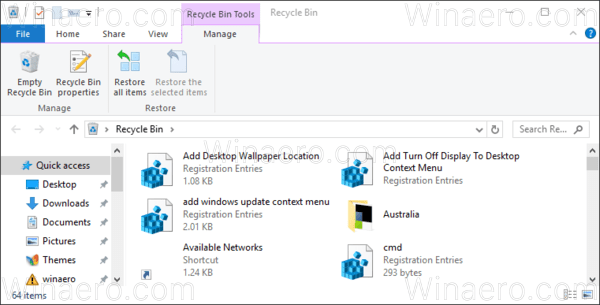In this article, I will be sharing information on how you can fix a corrupted Recycle Bin in Windows 10 so that you can restore your deleted files and get peace of mind. Add Recycle Bin again. There is a way you can remove the Recycle Bin and then read it back, that can solve the problem. Right click or press and hold on the Recycle Bin, and click/tap on Properties. Select the Recycle Bin location for the drive (ex: C ) you want at the top. Do step 4 (on) or step 5 (off) below for what you would like to do. Turn On Permanently Delete Files for Selected Recycle Bin.
Hi,
Thank you for being a part of Windows 10 Insider Preview.
I appreciate you for providing details about the issue and we are happy to assist you.
Windows Delete Without Recycle Bin
Please be informed that, if you are pressing Delete key from the Keyboard then the deleted data will reside in the Recycle Bin. If you are pressing Shift + Delete keys from the Keyboard then the deleted data will not reside in the Recycle Bin
I suggest you to follow the below steps to change settings of the Recycle Bin:
Right click on the Recycle Bin from the Desktop.
Click on Properties.
Change the option from Don’t move files to Recycle Bin. Removes files immediately when deleted to Custom size.
Check mark on Display delete confirmation dialog.
How To Delete Files From Recycle Bin Windows 10
Reference: Refer to the following Microsoft article on Windows 10 help & how-to.

Kindly let us know if you need any further assistance with Windows. We are glad to assist you.
Thank you.
Hi Harshavardhan
I have followed your advice but still face the same problem. Items deleted on my computer is getting permanently deleted instead of going to the recycle bin. Please help.
Regards
Michael
The Recycle Bin, that wastebasket icon in the upper-left corner of your Windows 10 desktop, works much like a real recycle bin. Shown here, it lets you retrieve the discarded desktop files you thought you’d never need.
You can dump something from the desktop — a file or folder, for example — into the Recycle Bin in either of these ways:
Simply right-click the unwanted item and choose Delete from the pop-up menu. Windows asks cautiously if you’re sure that you want to delete the item. Click Yes, and Windows dumps it into the Recycle Bin, just as if you’d dragged it there. Whoosh!
For a quick deletion rush, click the unwanted object and poke your Delete key.
Want something back? Double-click the Recycle Bin icon to see your recently deleted items. Right-click the item you want and choose Restore. The handy little Recycle Bin returns your precious item to the same spot where you deleted it. (You can also resuscitate deleted items by dragging them to your desktop or any other folder; drag ’em back into the Recycle Bin to delete them again.)
The Recycle Bin can get pretty crowded. If you’re searching frantically for a recently deleted file, tell the Recycle Bin to sort everything by the date and time you deleted it: Right-click an empty area inside the Recycle Bin and choose Sort By. Then choose Date Deleted from the pop-up menu.
Permanently Delete Files From Recycle Bin Windows 10
To delete something permanently, just delete it from inside the Recycle Bin: Click it and press the Delete key. To delete everything in the Recycle Bin, right-click the Recycle Bin icon and choose Empty Recycle Bin.
To bypass the Recycle Bin completely when deleting files, hold down Shift while pressing Delete. Poof! The deleted object disappears, ne’er to be seen again — a handy trick when dealing with sensitive items, such as credit-card numbers or late-night love letters meant for a nearby cubicle dweller.
Delete Recycle Bin Files Windows 10 Free
The Recycle Bin icon changes from an empty wastepaper basket to a full one as soon as it’s holding any deleted file or files.
The Recycle Bin holds only items deleted from the desktop. It doesn’t retain information deleted from Start menu apps.
Your Recycle Bin keeps your deleted files until the garbage consumes about 5 percent of your computer’s available space. Then it purges your oldest deleted files to make room for the new. If you’re low on hard drive space, shrink the bin’s size by right-clicking the Recycle Bin and choosing Properties. Decrease the Custom Size number to purge the bin more quickly; increase the number, and the Recycle Bin hangs onto files a little longer.
The Recycle Bin saves only items deleted from your own computer’s drives. That means it won’t save anything deleted from a CD, memory card, phone, MP3 player, flash drive, or digital camera.
Already emptied the Recycle Bin? You might still be able to retrieve the then-trashed-now-treasured item from the Windows File History backup.
If you delete something from somebody else’s computer over a network, it can’t be retrieved. The Recycle Bin holds only items deleted from your own computer, not somebody else’s computer. (For some awful reason, the Recycle Bin on the other person’s computer doesn’t save the item, either.) Be careful.